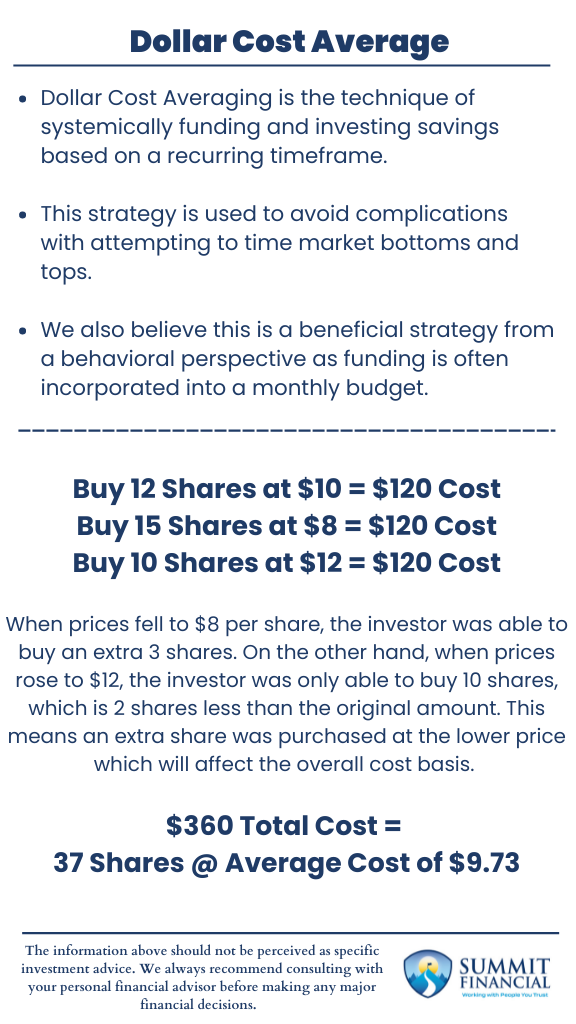- Dollar Cost Averaging is the technique of systemically funding and investing savings based on a recurring timeframe.
- This strategy is used to avoid complications with attempting to time market bottoms and tops.
- We also believe this is a beneficial strategy from a behavioral perspective as funding is often incorporated into a monthly budget.
Market Volatility and Investor Hesitation
Market volatility has raised a lot of questions with clients regarding whether or not they should be funding investment accounts at this time. This recent mindset is a brief glimpse into behavioral finance and how investors view risk at different points in time.
We believe there is much more hesitation during the volatile 2022 rather than the bubble-like rally we saw in 2020 and 2021. However, we have seen that prices have fallen substantially this year, so technically stocks and bonds could be viewed as “on sale” or “cheap” compared to the price levels the past couple of years.
What Is Dollar Cost Averaging?
A general philosophy for long-term investors is to Dollar Cost Average into your positions over time. This strategy is defined as consistent funding and investing regardless of current prices and recent volatility. (Investopedia.com)
The keyword is consistent. We believe the most efficient strategy would be to sit in cash until the market bottoms and then buy all in at that exact point in time. However, that is a very difficult task, even for the most experienced wealth managers.
Trying to time the market bottoms and tops can be very detrimental to your long-term savings potential, not to mention the stress that comes along with it.

What are the Benefits of Dollar Cost Averaging?
Dollar Cost Averaging is beneficial during market downturns as you will continue to buy more and more shares as prices fall. This will lead to your average cost per share being lower than when you initially started to buy. However, this strategy will raise your average cost during a bull market as you continue to buy shares at higher prices.
Also, when prices rise and you invest the same amount, you will be buying fewer shares. More shares are bought with the recurring investment amount when prices fall.
This strategy will tend to lower your overall cost basis if followed over a longer term.
What are the Risks of Market Timing?
Trying to time the market may lead to missed opportunities or mistakes that lead to a higher cost basis in any scenario. With a long-term view, the market will likely recover from volatility and lead towards higher levels, so it may be more beneficial just to invest the savings rather than trying to time entry points perfectly.
Dollar Cost Averaging supports the old saying of “time in the market is more important than timing the market.”
Trying to time the market may cause you to miss potential gains, so focusing on your savings being invested sooner may increase your growth potential over the longer term.
How to Budget a Dollar Cost Average Strategy
This strategy can also be especially useful from a budgeting and psychology perspective. For example, lets consider the $6,000 IRA contribution limit (at this time of this original writing.) Investors who are following the Dollar Cost Average strategy would choose to invest $500 per month.
Someone trying to time the market may hold onto all $6,000 until they hopefully identify the best opportunity for the year and then invest it all at once. This could backfire if prices rise all year and they invest the lump sum near the deadline, or it may benefit them if the market falls all year, and the best price is near the contribution deadline.
However, we believe consumer behavior has shown us that some individuals would struggle to hold onto that $6,000 for a longer period and may end up spending it on something other than retirement savings.
By using the Dollar Cost Average at $500 per month, this builds the savings into your monthly budget and forces you to commit to that goal. You are more likely to follow your savings plan when it is set up as a systemic or recurring investment.
Speak With a Trusted Advisor
If you have any questions about your investment portfolio, retirement planning, tax strategies, our 401(k) recommendation service, or other general questions, please give our office a call at (586) 226-2100.
Please feel free to forward this commentary to a friend, family member, or co-worker. If you have had any changes to your income, job, family, health insurance, risk tolerance, or your overall financial situation, please give us a call so we can discuss it.
We hope you learned something today. If you have any feedback or suggestions, we would love to hear them.
Sincerely,
Zachary A. Bachner, CFP®
with contributions from Robert Wink, Kenneth Wink, James Wink, and James Baldwin
If you found this article helpful, consider reading:
Sources:
https://www.investopedia.com/terms/d/dollarcostaveraging.asp
https://www.nerdwallet.com/article/investing/dollar-cost-averaging-2


